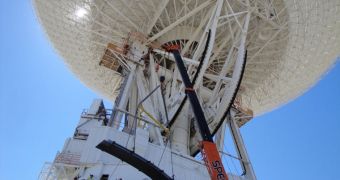After more than seven months of hard work, engineering crews at NASA have finally concluded work on the space agency's famous “Mars antenna.”
This is the most widely-used name for the NASA Deep Space Network (DSN), which is located in Goldstone, California, and that is used primarily to contact rovers and orbiters circling the Red Planet.
At this point, the two Mars Exploration Rovers (MER), Spirit and Opportunity, communicate with Earth using their low-gain antennas, which send data to the Mars Reconnaissance Orbiter or Mars Odyssey.
The orbiters then relay the message to NASA, as they have more power in space. When the rovers use their high-gain antennas to contact Earth directly, they do so through the DSN.
The gigantic antenna was taken out of commission earlier this year so that engineers could change degraded components, and upgrade its functionality to support a new decade of space exploration.
Throughout October, all the systems pertaining to antenna operations were tested and double-tested, and a large number of simulations was conducted to assess the functionality of the new product.
All of the experts that worked on the DSN had a very clear mission – they were to complete repairs to the antenna until the EPOXI mission caught up with Comet Hartley 2. The flyby takes place on November 4, so the work was finished in time.
On September 28, the antenna made its first official transmission after the repairs, communicating with the EPOXI mission, which was tracking its target in the inner solar system at the time.
“We've been testing the antenna since Sept. 28, and we've had no problems in tracking the spacecraft,” explains NASA Jet Propulsion Laboratory (JPL) expert Peter Hames.
He is in charge of ensuring that all the antennas in NASA's networks are functioning properly at all times. “We are ready to resume service as scheduled,” he adds.
The DSN repair process involved a portion of the antenna being lifted by 5 millimeters from its base, so that engineers could do precise maintenance work on basic components.
The thing about that piece of antenna is that it weighs 7 million pounds, or about 3.2 million kilograms. The antenna itself has a diameter of 70 meters, or 230 feet.
It goes without saying that this antenna is critical to NASA. It now controls both Mars rovers, the Cassini orbiter around Saturn, the Voyager spacecrafts at the edge of the solar system, as well as the infrared Spitzer Space Telescope.
“We are nearing the completion of a very challenging engineering effort that will extend the life of one of the DSN's workhorses, making it more available and reliable in returning critical science data through at least 2025,” adds JPL DSN deputy project manager Wayne Sible.

 14 DAY TRIAL //
14 DAY TRIAL //